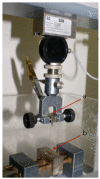Evaluation of Breaking Force of Different Suture Materials Used in Dentistry: An In Vitro Mechanical Comparison
- PMID: 35161027
- PMCID: PMC8840186
- DOI: 10.3390/ma15031082
Evaluation of Breaking Force of Different Suture Materials Used in Dentistry: An In Vitro Mechanical Comparison
Abstract
The success of surgical procedures is strictly related to the biomechanical properties of the suture. Mechanical comparisons are scarcely reported in the literature, so the purpose of the present study was to evaluate and compare the mechanical behavior of different sutures commonly used in oral surgery in terms of traction resistance. Sutures made of eight different materials were analyzed: silk (S), polyglycolide-co-caprolactone (PGCL), polypropylene (PP), rapid polyglycolide (rPGA), standard polyglycolide (PGA), polyamide (PA), polyester (PE), and polyvinylidene fluoride (PVDF). For each material, three different sizes were tested: 3-0, 4-0, and 5-0. The breaking force of each suture was assessed with a uniaxial testing machine after being immersed in artificial saliva at 37 °C. The outcomes analyzed were the breaking force, the needle-thread detachment breaking-point and the node response after forward-reverse-forward (FRF) tying when subjected to a tensile force. The 3-0 rPGA provided the maximum resistance, while the lowest value was recorded for the 5-0 PGCL. In general, 3-0 and 4-0 gauges showed non-statistically significant differences in terms of needle-thread detachment. The highest needle-thread detachment was found for the 3-0 PGA, whereas the lowest value was observed for the 5-0 PGCL. After tying the knot with an FRF configuration, the thread that showed the highest resistance to tension was the 3/0 silk, while the thread with the lowest resistance was the 5/0 silk. These data should be considered so that the operator is aware of as many aspects as possible on the behavior of various materials to ensure successful healing.
Keywords: breaking force; oral surgery; suture materials; wound healing.
Conflict of interest statement
The authors declare no conflict of interest.
Figures




Similar articles
-
Evaluation of Tensile Strength of Surgically Absorbable Suture Materials Used in Oral Surgery after Immersion in Different Beverages: An In Vitro Study.Materials (Basel). 2024 Jul 20;17(14):3586. doi: 10.3390/ma17143586. Materials (Basel). 2024. PMID: 39063878 Free PMC article.
-
Why make monofilament sutures out of polyvinylidene fluoride?ASAIO J. 1994 Apr-Jun;40(2):145-56. ASAIO J. 1994. PMID: 8003751
-
[Mechanical Testing of Tendons Sutured with Newly Developed Biomaterial].Acta Chir Orthop Traumatol Cech. 2020;87(3):210-214. Acta Chir Orthop Traumatol Cech. 2020. PMID: 32773023 Czech.
-
Immediate effect of different herbal solutions on tensile strength of suture materials in oral cavity.Heliyon. 2024 Jul 26;10(15):e35241. doi: 10.1016/j.heliyon.2024.e35241. eCollection 2024 Aug 15. Heliyon. 2024. PMID: 39161830 Free PMC article.
-
In Vitro Tensile Strength Study on Suturing Technique and Material.J Oral Implantol. 2017 Jun;43(3):169-174. doi: 10.1563/aaid-joi-D-16-00164. Epub 2017 Mar 16. J Oral Implantol. 2017. PMID: 28301295
Cited by
-
Assessment of the Impact of Commonly used Beverages on Durability of Suture Materials: An In Vitro Study.J Pharm Bioallied Sci. 2023 Jul;15(Suppl 1):S447-S450. doi: 10.4103/jpbs.jpbs_575_22. Epub 2023 Jul 5. J Pharm Bioallied Sci. 2023. PMID: 37654402 Free PMC article.
-
Surgical Correction and Oral Health-Related Quality of Life (OHRQoL) Evaluation of Non-syndromic Congenital Double Lip: A Case Report and Literature Review.Cureus. 2024 Feb 2;16(2):e53446. doi: 10.7759/cureus.53446. eCollection 2024 Feb. Cureus. 2024. PMID: 38435189 Free PMC article.
-
Pressure-Spun Fibrous Surgical Sutures for Localized Antibacterial Delivery: Development, Characterization, and In Vitro Evaluation.ACS Appl Mater Interfaces. 2023 Oct 4;15(39):45561-45573. doi: 10.1021/acsami.3c07956. Epub 2023 Sep 20. ACS Appl Mater Interfaces. 2023. PMID: 37729472 Free PMC article.
-
Drug-Eluting Sutures by Hot-Melt Extrusion: Current Trends and Future Potentials.Materials (Basel). 2023 Nov 20;16(22):7245. doi: 10.3390/ma16227245. Materials (Basel). 2023. PMID: 38005174 Free PMC article. Review.
-
Chemical Structures, Properties, and Applications of Selected Crude Oil-Based and Bio-Based Polymers.Polymers (Basel). 2022 Dec 19;14(24):5551. doi: 10.3390/polym14245551. Polymers (Basel). 2022. PMID: 36559918 Free PMC article. Review.
References
LinkOut - more resources
Full Text Sources
Miscellaneous

